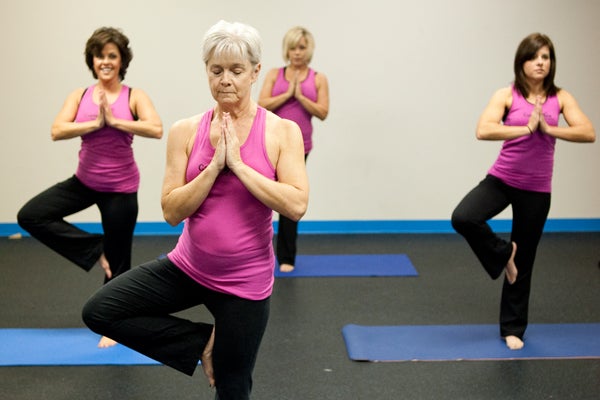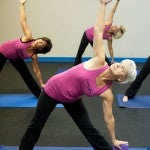
By Kerri Kelley
Can you breathe? Then you can practice yoga, Donna Hill, a yoga enthusiast and certified group instructor at Cornerstone Fitness and Wellness, insists.
In fact, she stresses the importance of breathing and how it pertains to everyday life.
“We are created to breathe from our belly all the way up,” she said.
Most people, according to Hill, breathe only from the chest, creating a signal to our bodies that we are stressed, which increases blood pressure. This chest breathing is defined as thoracic breathing.

Yoga combines thoracic breathing with abdominal breathing.
In a full yogic breath, you first inhale by filling the abdomen and then continue inhaling as you expand and fill the chest.
The exhale starts at the chest. As it empties and falls, you continue to exhale from the abdomen as it draws inwards completely.
This is one round of the full yogic breath.
Hill explains that this type of breathing is a learned method — as is the balance and poses associated with yoga.
Each is a building block for the other, so consistency and repetition is key.
Yoga, a no impact exercise, combines strength, cardio, flexibility and relaxation, offering health and wellness benefits for the mind and body.
Hill points out that during her yoga class students are often reminded to breathe and allow their minds to shift to a relaxing state, “something that we often fail to do in everyday life,” she adds.
This focus and relaxation is part of the mental benefits, but the rewards don’t stop there.
Physical benefits such as a leaner, longer look are reason enough for some to practice yoga, but many more with ailments and injuries swear by the exercise.
Yoga has been credited to relieving aching in the hips, neck and back.
“You are only as young as your spine,” Hill says lightheartedly.
While it may be humorous to consider that adage, the condition of your spine is often linked to overall health.
You may have heard yoga associated with better posture, lengthening muscles, even those who declare that they’ve gained a few inches just by this type of physical fitness. This is not far fetched.
There are five basic movements of the spine – flexing (curling forward), extension (upward stretching), axial rotation (reaching something behind you), lateral flexion (side to side bending) and axial extension (which is not considered a natural movement).
Of the five, axial extension is said to be the one learned by the practice and technique of yoga, which, generally speaking, means it aligns and straightens the curvature of your spine beyond natural posture.
After a while, this movement is what ultimately offers the lengthening, better posture, and could be the result of a positive snowball effect into other overall health benefits.
Anyone at almost any fitness level should be able to enjoy the benefits of yoga, says Hill, who offers two classes per week at Cornerstone Fitness and Wellness.
“Yoga is not a competitive exercise. It is about focusing on you and where you are in your own level of fitness —just being in the moment,” she said.
To help, there are props such as blocks and straps for beginners, those who may have injury or just lack a bit of flexibility or balance.
Good form is most important for safety and to receive the most benefits, and Hill assures that her classes are welcoming. Dim lighting, soft music as well as constant instruction on how to breathe and modify make the setting comfortable for everyone.”
“We fall, we laugh, we have fun,” Hill says.
For more information, call 205-280-6450 or visit cornerstonefitnesswellness.com.
